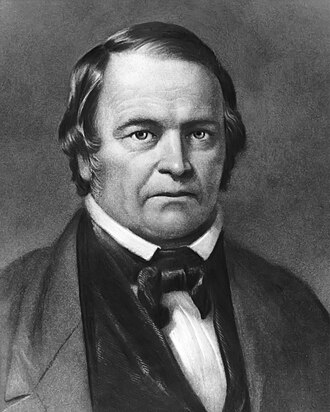Investiture Achievement/Friend/Spiritual Discovery
The Great Disappointment was a period in the early history of certain Christian denominations in the United States, which began when Jesus failed to reappear on the appointed day of October 22, 1844 as some Christians had expected.
Overview
Between 1831 and 1844, William Miller, a Baptist preacher, launched what has been called by historians as Second Great Awakening, of which the Millerite movement was a major part. Miller preached a set of fourteen rules for the interpretation of the Bible.& Based on his study of the prophecy of Template:Bibleverse, Miller calculated that Jesus would return to Earth sometime between 21 March 1843 and 21 March 1844.& After the latter date came and went, the date was revised and set as October 22, 1844 based on the yearly Day of Atonement in Karaite Judaism.
When Jesus did not appear, Miller's followers experienced what came to be called "the Great Disappointment". Most of the thousands of followers left the movement. A few, however, went back to their Bibles to find out why they had been disappointed. A group of the remaining followers concluded that the prophecy predicted not that Jesus would return in 1844, but that the investigative judgment in heaven would begin in that year.
Miller recorded his personal disappointment in his memoirs: "Were I to live my life over again, with the same evidence that I then had, to be honest with God and man, I should have to do as I have done. I confess my error, and acknowledge my disappointment."& Miller continued to wait for the second coming until his death in 1849.
Repercussions
Seventh-day Adventists
Seventh-day Adventist Church historians writing about the morning of 23 October refer to a vision said to have been received by Hiram Edson, an early Adventist.& Edson claimed he had a vision that indicated the date predicted by Miller was in fact correct. Later Bible study and visions led to the belief by the early Seventh-day Adventists that Christ went into the second apartment of the heavenly sanctuary in 1844 to begin the investigative judgment of both righteous and wicked to see who is worthy of going to heaven.& This investigative judgment is said to take place prior to his second coming, which they believed to be very soon. Numerous issues related to the doctrine of this investigative judgement were raised by Adventist theologian Desmond Ford in the 1970s.
Jehovah's Witnesses
Jonas Wendell, an Adventist preacher, experienced periods of weak faith after 1844. After studying Bible chronology, he came to the conclusion that the Second Coming would be in 1868, and in 1870 he published a booklet concluding it was to be in 1873.
Charles Taze Russell was in turn influenced by Jonas Wendell (as well as by the Millerites in general). One-time Millerite ministers George Storrs (1796-1879), George Stetson and Nelson H. Barbour were also influential in Russell's doctrinal development. Like Wendell, Barbour had also predicted Christ's return in 1873, and when that failed, he revised the prediction for 1874. Soon after that disappointment, Barbour's group came to believe that Christ had returned in 1874 but invisibly. Russell met Barbour in 1876 and accepted the teaching of an invisible presence of Christ from Barbour. Russell developed an elaborate chronology with 1914 being viewed as the end of a forty year "harvest period." A schism in the movement occurred after Russell's death. In the early 1930s, the leadership changed the date of the Second Coming to 1914. The main branch of that movement came to be known as the Jehovah's Witnesses, while many members refused the change; Bible Students today still hold that the Second Coming was in 1874.
Religious studies
The Great Disappointment is viewed as an example of how the psychological phenomenon of cognitive dissonance manifests itself through failed prophecies which often arise in a religious context.& The theory was proposed by Leon Festinger to describe the formation of new beliefs and increased proselyting in order to reduce the tension, or dissonance, that results from failed prophecies. According to the theory, believers experienced tension following the failure of Jesus' reappearance in 1844 which led to a variety of new explanations. The various solutions form a part of the teachings of the different groups that outlived the disappointment.
Other references
Bahá'í
Members of the Bahá'í Faith believe that Miller's interpretation of signs and dates of the coming of Jesus were, for the most part, correct. They believe that the fulfillment of biblical prophecies of the coming of Christ came through a forerunner of their own religion, the Báb, who declared that he was the "Promised One" on May 23, 1844, and began openly teaching in Persia in October 1844.& Several Bahá'í books and pamphlets make mention of the Millerites and the prophecies used by Miller, most notably William Sears' Thief in the Night. &
References
- ↑ Miller's Rules of Scriptural Interpretation
- ↑ Miller Mistakenly Set a Date for Christ's Return
- ↑ 3.0 3.1 Sears, William (1961). Thief in the Night. London: George Ronald. ISBN 0-85398-008-X.
- ↑ Sanctuary
- ↑ 28 Fundamental SDA beliefs #24
- ↑ James T. Richardson. "Encyclopedia of Religion and Society: Cognitive Dissonance". Hartland Institute. http://hirr.hartsem.edu/ency/cogdisso.htm. Retrieved 2006-07-09.
- ↑ Hatcher, William S. and Martin, J. Douglas (1998). The Bahá'í Faith: The Emerging Global Religion. Wilmette, Illinois, USA: Bahá'í Publishing Trust. ISBN 0-87743-264-3.
- Stone, Jon R. (2000). Expecting Armageddon: Essential Readings in Failed Prophecy. Routledge. ISBN 0-415-92331-X.
hu:Nagy Kiábrándulás pl:Wielkie rozczarowanie pt:O Grande Desapontamento

